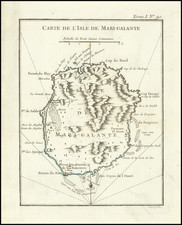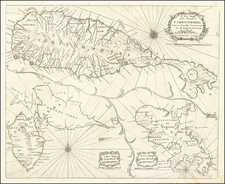Interesting map of Antigua by Herman Moll.
Shows churches, forts, windmills, plantation, cattle mills, submerged rocks, etc. Depths shown by soundings.
Published by the esteemed cartographer Herman Moll in London in 1730, the map provides a look at the the early history of this fascinating Caribbean island.
Antigua, part of the Leeward Islands in the Caribbean, was discovered by Christopher Columbus in 1493 during his second voyage to the New World. He named the island "Santa Maria de la Antigua" after the venerated saint of Seville.
This small map of Antigua, drawn with remarkable precision by Moll, showcases the geographical features, settlements, and major plantations of the island during the early 18th century. The map also highlights Antigua's strategic importance as a British naval base, with English Harbor on the southeastern coast serving as the main hub for British naval operations in the region.
By the time of the map's publication, Antigua had already undergone significant transformations due to European colonization. The British first established a settlement on the island in 1632, and by 1667, the Treaty of Breda confirmed British sovereignty over Antigua. The island's fertile soil and favorable climate made it an ideal location for the cultivation of sugarcane, which subsequently led to a rapid expansion of the plantation economy. African slaves were forcibly brought to the island to work on these plantations, and by the mid-18th century, the population of enslaved Africans vastly outnumbered that of white settlers.
Herman Moll (c. 1654-1732) was one of the most important London mapmakers in the first half of the eighteenth century. Moll was probably born in Bremen, Germany, around 1654. He moved to London to escape the Scanian Wars. His earliest work was as an engraver for Moses Pitt on the production of the English Atlas, a failed work which landed Pitt in debtor's prison. Moll also engraved for Sir Jonas Moore, Grenville Collins, John Adair, and the Seller & Price firm. He published his first original maps in the early 1680s and had set up his own shop by the 1690s.
Moll's work quickly helped him become a member of a group which congregated at Jonathan's Coffee House at Number 20 Exchange Alley, Cornhill, where speculators met to trade stock. Moll's circle included the scientist Robert Hooke, the archaeologist William Stuckley, the authors Jonathan Swift and Daniel Defoe, and the intellectually-gifted pirates William Dampier, Woodes Rogers and William Hacke. From these contacts, Moll gained a great deal of privileged information that was included in his maps.
Over the course of his career, he published dozens of geographies, atlases, and histories, not to mention numerous sheet maps. His most famous works are Atlas Geographus, a monthly magazine that ran from 1708 to 1717, and The World Described (1715-54). He also frequently made maps for books, including those of Dampier’s publications and Swift’s Gulliver’s Travels. Moll died in 1732. It is likely that his plates passed to another contemporary, Thomas Bowles, after this death.









![[Heighted with Gold] Pascaert Vande Caribes Eylanden](https://storage.googleapis.com/raremaps/img/small/91150.jpg)

![A New & Accurate Map of Bermudas or Sommer's Islands [with] An Accurate Map of the Island of St. Christopher, vulgarly called St. Kits . . .](https://storage.googleapis.com/raremaps/img/small/77156.jpg)
![Cuba Insula [with] Hispaniola Insula [with] Insula Jamaica [with] Ins. S. Ioannis [with] I.S. Margareta Cum Confiniis](https://storage.googleapis.com/raremaps/img/small/95802.jpg)

